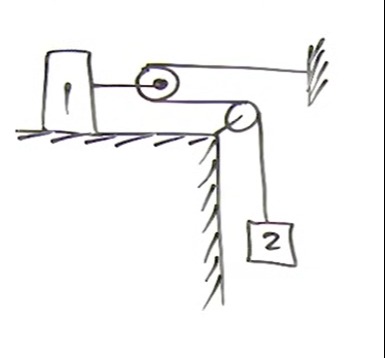Question
Question: A block of mass $m_1$ is placed on a frictionless horizontal surface. A string is attached to the bl...
A block of mass m1 is placed on a frictionless horizontal surface. A string is attached to the block, passes over two fixed pulleys, and is then attached to a hanging mass of m2. Determine the acceleration of the system.

The acceleration cannot be determined without knowing the masses m1 and m2.
The acceleration is a=m1+m2m1g.
The acceleration is a=m1+m2m2g.
The acceleration is a=m2m1g.
The acceleration is a=m1+m2m2g.
Solution
The system consists of a block of mass m1 on a frictionless horizontal surface and a hanging mass of m2, connected by a string passing over two fixed pulleys. Let T be the tension in the string and a be the magnitude of the acceleration of the system.
Applying Newton's second law to the block of mass m1 on the horizontal surface: The only horizontal force is the tension T pulling it to the right. ΣFx=m1a T=m1a (Equation 1)
Applying Newton's second law to the hanging mass m2: The forces acting on m2 are its weight m2g downwards and the tension T upwards. Since the mass is accelerating downwards, the net force is m2g−T. ΣFy=m2a m2g−T=m2a (Equation 2)
Now, substitute the expression for T from Equation 1 into Equation 2: m2g−(m1a)=m2a
Rearrange the terms to solve for a: m2g=m1a+m2a m2g=(m1+m2)a
Therefore, the acceleration of the system is: a=m1+m2m2g
